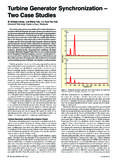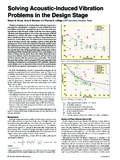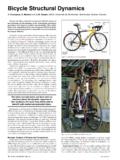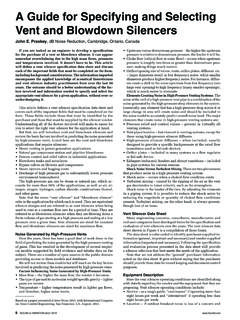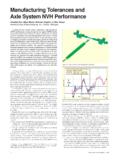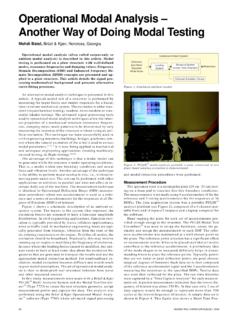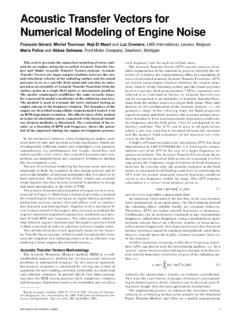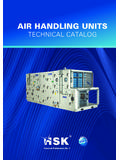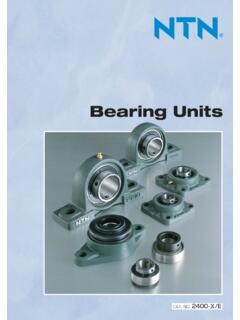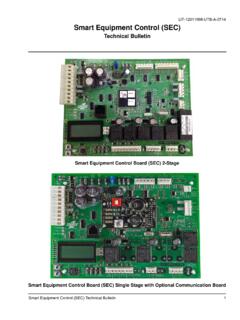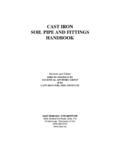Transcription of Noise Standards for HVAC Equipment
1 SOUND & VIBRATION/DECEMBER 2014 Noise Standards for HVAC Equipment260270300350370575880Ai r- handling Units, Fan Coils, etc. Water-Cooled Chillers* Ai r-Cooled Chillers Ai r-Terminal Devi ces Outdoor Condensing Units Water-Source Heat Pumps Ducted Packaged EquipmentIndoor Outdoor PTAC/PTHP Lw (63 - 8000 Hz) Lw (125 - 8000 Hz) Lw (125 - 4000 Hz) LwA TL, STC and OITC Lp (63 - 8000 Hz) *AHRI Standard 575 is not a rating standard, but it is used like RATING STANDARDEQUIPMENT TYPEOCTAVE-BAND SOUND POWEROCTAVE-BAND SOUND PRESSURELpATable 1. AHRI Equipment sound rating shift toward improving the energy efficiency and sustain-ability of buildings has often resulted in HVAC Equipment being located closer to the occupants, where sound from the Equipment is now critical to the success of the building design. To assist designers, the Air-Conditioning, Heating, and Refrigeration Institute (AHRI) publishes Standards on Equipment sound mea-surement and rating.
2 These Standards provide a level playing field for HVAC Equipment manufacturers to rate their products, yet these Standards are seldom referenced correctly, if at all, in project specifications. This article provides an overview of AHRI Standards related to sound, including methods of test, product ratings and applying these ratings to predicting sound in the built past two decades have seen a strong emphasis toward im-proving the energy efficiency and sustainability of buildings. This shift in building design has created a renewed interest in building occupant comfort and performance, particularly as it relates to indoor environmental quality (IEQ) factors such as ,2 To meet new building energy and sustainability requirements, HVAC Equipment is being located closer to the building occupants, and the sound from this Equipment is now critical to the success of new building designs. Now, more than ever, there is a need to understand how to measure, rate, specify and apply sound data from HVAC Air-Conditioning, Heating, and Refrigeration Institute (AHRI) publishes Standards related to HVAC Equipment sound.
3 The AHRI Technical Committee on Sound (TCoS) has the responsibil-ity for all sound-related Standards , and each standard requires a two-thirds majority approval at all stages of development. These Standards are available at no cost from the AHRI Many of these Standards are also approved ANSI Standards . AHRI sound Standards come in three basic types: Rating Standards for various types of Equipment Methods of test that are referenced by the rating Standards Application StandardsAn overview of AHRI rating Standards by type of Equipment is shown in Table 1. Rating Standards cover the scope of Equipment and requirements for the test setup, test operating conditions and reporting requirements of HAVC Standard 270 applies to outdoor sections of air-condition-ing and heat-pump unitary Equipment less than 40 kW capacity (11 tons). AHRI Standard 370 applies to outdoor air-cooled portions of large commercial air-conditioning and refrigeration Equipment greater than 40 kW Standard 260 applies to any Equipment that has a duct connection, from large air-handlers to small fan coils.
4 Ducted packaged Equipment includes outdoor rooftop units and indoor air-conditioning units. Rooftops are an example of Equipment that might be rated according to two Standards the air-handler sec-tion would be rated to 260, while the outdoor condensing section would be rated to either 270 or Standard 350 covers all Equipment that operates at free inlet and outlet conditions (ductless), such as unit ventilators and vertical fan coils. AHRI 880 applies to variable air volume (VAV) terminal units, single-ducted and 300 applies to packaged terminal air conditioning (PTAC) and heat pump (PTHP) Equipment that is mounted through the wall, typically found in motel rooms. Because they also have a significant airborne path from the outside to inside, the sound trans-mission loss (TL, STC and OITC) is also part of the product 1 also shows the required sound data that are reported for the product rating. Typically the octave-band sound power levels from 63 Hz to 8000 Hz are required.
5 Smaller Equipment such as unitary outdoor condensers and VAV terminal units are only rated from 125 Hz and up. For some products, the overall A-weighted sound power levels are required. These products are usually located outdoor or very near the occupant, where distance attenuation applies. AHRI Standard 575 is the only standard that reports sound pressure levels. This standard was originally written to define a method of measuring the sound pressure level in Equipment rooms, where the risk of hearing loss was the primary concern. Over time, this standard became the de facto standard for rating water-cooled chiller sound. This may change soon, since AHRI is working on a sound power standard for water-cooled Equipment (AHRI 1280) that is covered in more detail in another NC14 AHRI 575 is a useful tool for measuring Noise in the field and will remain in the AHRI portfolio of important part of AHRI ratings Standards is the requirements for operating the unit during test.
6 The determination and stability of the operating point can be a significant cause of variability in sound test data between In general, catalog sound ratings are required at the standard thermal rating conditions for the type of Equipment . Some Standards , however, such as AHRI 260, require that the full operating map be tested. Most Standards permit application ratings to be published, and manufacturers often provide these ratings in computer selection programs. Custom-ers will sometimes require units be tested at specific application conditions as part of a sales major HVAC product is missing from the list in Table 1, vari-able refrigerant flow (VRF). These systems mix and match several types of outside condensing units with several types of indoor evaporator units, which are typically ductless. These systems are pervasive in Asia and South America, and are now becoming more prevalent in North America. At present the only published data are based on a Japanese test method, JIS B8616.
7 The results are presented as A-weighted or octave-band sound pressure levels at a distance from the unit . Other than fan speeds, little information is provided on operating conditions. This product may be covered by AHRI sound Standards in the final note, VAV terminal units are the only products that Curtis Eichelberger and Paul Bauch, Johnson Controls, York, PennsylvaniaBased on a paper presented at Noise -Con 2014, Fort Lauderdale, FL, Sep-tember SOUND & VIBRATION/DECEMBER 2014 13have certified sound data (according to AHRI Standard 880). The certification program requires annual verification testing by a third party laboratory. The products to be tested are selected by AHRI staff and not by the manufacturer. A certification program for other HVAC products is difficult, given the variety of configurations and options that are available from most manufactures. Nevertheless, we may see more certification programs for AHRI sound ratings in the MethodsHVAC Equipment ratings start with a basic understanding of how the Equipment is tested.
8 Table 2 is an overview of all the test Standards referenced by AHRI Standards . There are three general categories of test Standards : comparison method in a reverberation room, sound intensity and free Standard 220 describes the methodology for determining sound power levels in a reverberation room by comparing with a reference sound source (RSS). This standard is based on ANSI 3741, and was written in 2007 to overcome several is-sues with the ISO 3741 and ANSI Standards . These general test Standards allow multiple source positions and do not require measurements below the 100 Hz third-octave band. Moving the source is generally not feasible for large HVAC Equipment . More-over, the HVAC industry for large air handlers and chillers demands data down to and including the 63-Hz octave band. This requires a fairly large reverberation room and a method for calibrating the reference sound source (RSS) down to the 50-Hz third-octave address the RSS calibration issue, AHRI also developed AHRI Standard 250 that permits use of sound intensity in the low frequencies and transfer calibration in a reverberation room at 100 Hz and , AHRI 220 was the first industry standard to require discrete frequency qualification of the reverberation room.
9 This is an option in all other reverberation room test Standard 230, sound intensity method of test, was ap-proved in 2013. Presently only AHRI 260 includes sound intensity testing. By the end of 2016, however, it is likely that most of the rating Standards will include this method of test. AHRI Standard 230 is based on ISO 9614-1 (grade 2), ISO 9614-2 (grade 2) and ANSI Sound intensity can be performed in environments that are not ideal, but the methodology can be tedious and requires a high level of skill with the instrumentation. AHRI Standard 230 borrows the performance verification with a reference sound source concept from ANSI This assures that the person performing the test has the requisite skills. Sound intensity is an excellent method to use where a limited number of operating conditions are needed, such as a customer sales order of the AHRI TCoS s objectives is to assure that all AHRI test methods have equivalent uncertainty (reproducibility).
10 5,6 The sound intensity and reverberation room methods have equivalent test reproducibility so that when these Standards are referenced there is no question about the grade or quality of the test data. AHRI TCoS is presently conducting an interlaboratory compari-son on all referenced test methods: AHRI 220, AHRI 230 and ISO 3744/3745. Several member firms and one independent laboratory are testing a standardized sound source to determine broadband and discrete frequency reproducibility for all test methods. This work is being conducted by the University of Nebraska and will be the basis of a new AHRI Standard 1150P on declaration and StandardsAHRI 885 provides a uniform method of calculating the sound pressure level and NC ( Noise Criteria) value in an occupied space served by VAV air terminals and/or air outlets. This standard was initially drafted in 1998. The method uses AHRI 880 radiated and discharge sound ratings and requires a detailed knowledge of the mechanical and architectural elements in the room.

